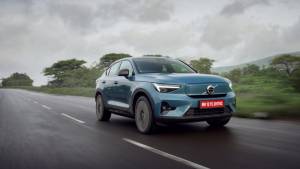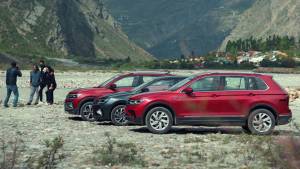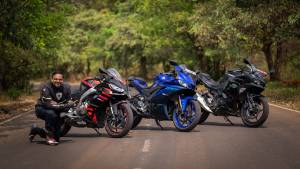Video: Volvo XC90's standard safety package includes run off-road protection
The new Volvo XC90's standard safety package now comes with run off-road protection which includes safety systems such as Lane Keeping Aid and Driver Alert Control. Volvo has designed these to help prevent the car from leaving the road and running into unpaved terrain. Running off-road has been identified as a major cause for serious crashes in vehicles, according to the Swedish carmaker.
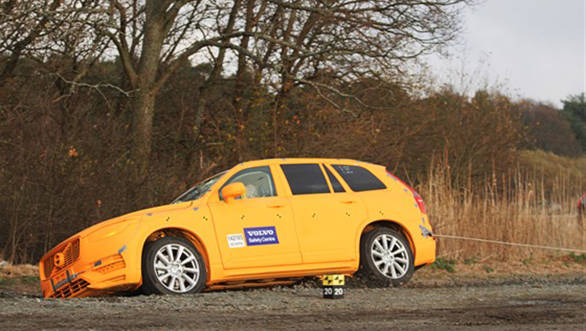
The company says that its engineers and designers haven't simply relied on a rating programme from another body but devised their own test track methods to ensure safety to Volvo passengers in the event of a crash caused by the car running off-road. Divided into three categories - Ditch, Airborne and Rough terrain these tests are conducted on dummies and advanced test rigs that help identify the resultant vertical forces and lateral or longitudinal movements. These test rigs include a human-kinematics simulating robot and an advanced dummy they've christened Thor, which gets "an enhanced flexible shoulder area to create more human-like movement in a run-off road scenario." Check the following video out to sample Volvo's test track methods.
[video width="586" height="340" mp4="https://stat.overdrive.in/wp-content/uploads/2014/12/Volvo_XC90_crash_test.mp4"][/video]
"Committing to safety is not about passing a test or getting a ranking," says Lotta Jakobsson, senior technical specialist safety at Volvo Cars Safety Centre, "It is about finding out how and why crashes and injuries occur and then developing the technology to prevent them. To reach our Vision 2020, we have to cover all accident types that occur in real-life traffic."
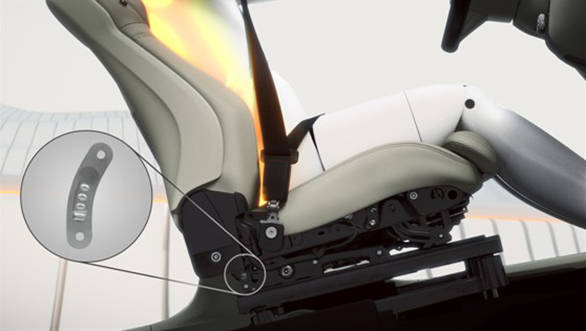
To combat injury-causing damage in case the crash is not prevented, Volvo has equipped the car's front safety belts with a provision that automatically tightens the belt when the car's sensors detect a run off-road scenario. This, the company says, keeps the occupant secure in an upright position. An energy-absorbing cushioning has also been inserted between the seat and seat frames to prevent the impact from getting transferred to the occupant's spine and sensitive lumbar or thoracic region.
In the interest of preventing the vehicle from running off-road, Lane Keeping Aid applies extra torque on the steering in the event that a car is about to leave the road unintentionally, while Driver Alert Control detects if the driver is inattentive and accordingly sends out alerts . The driver can also be directed to the closest rest location with the help of Rest Stop Guidance.
It is Volvo's belief that "addressing these common and complex situations" will get it a step closer to its aim of bringing the number of casualties in its vehicles down to zero, by 2020.
The XC90 is the fifth model to join Volvo's lineup in India preceded by the Volvo S80, S60, XC60 and the V40 Cross Country.
The all-new Volvo XC90 addresses dangerous run-off road crashes with world-first solution
| New Delhi, 8th December 2014: The standard safety package in the all-new Volvo XC90 includes a world-first run-off road protection package. Addressing these common and complex situations will take Volvo Cars another step closer to its vision that no one will be killed or seriously injured in a new Volvo car by 2020. "Our solution focuses on keeping the occupants firmly in position and introducing unique 'energy-absorbing' functionality in the seat. This counteracts spine injuries, which are serious and relatively frequent consequences of run-off road scenarios," says Prof. Lotta Jakobsson, Senior Technical Specialist Safety at Volvo Cars Safety Centre. Run-off road is a common accident type with different causes, such as driver inattentiveness, fatigue or poor weather conditions. For example, half of all traffic fatalities in the United States are road departure crashes, while in Sweden, single-vehicle accidents involve one-third of all fatal and severe injury crashes with passenger cars. Run-off road crashes are also very complex situations in which occupants often move in random directions which puts high demands on the interior restraints. Not covered by any rating programme There are not yet any regulatory or rating tests to examine a car's ability to handle run-off road crashes. "Committing to safety is not about passing a test or getting a ranking," says Lotta Jakobsson. "It is about finding out how and why crashes and injuries occur and then developing the technology to prevent them. To reach our Vision 2020, we have to cover all accident types that occur in real-life traffic." Spine injuries common in run-off road scenarios Injury trends in car accidents have changed over the years. A continuous development of car structure and implementation of different specialized safety systems have resulted in significant improvements in car safety over the past few decades. The risk of being seriously injured or killed in a new Volvo has been reduced by more than two-thirds compared with cars designed in the 1970s. However, in contrast to this significant overall injury risk reduction, the frequency of thoracic and lumbar spine injuries has not been reduced to the same extent and these injuries are overrepresented in run-off road scenarios, multiple impacts and multiple events. "Studying our own extensive accident data, we discovered that the occupant's posture during the load transfer through the spine is an important factor. In several of the cases, great occupant flexion was seen as an influencing factor. Anterior wedge fractures, resulting from a combination of axial load and flexion, are the most common spine injury in run-off road events together with compression fractures," says Lotta Jakobsson. Tightening belts and cushioning impact The run-off road protection solution in the all-new XC90 includes two vital parts: Using input from the car's advanced sensor system, the technology is able to detect a run-off road scenario. The front safety belts are electrically tightened as much as possible to retract and keep the occupants in position. The pulling capacity of the safety belt retractor is 1 mm/ms which means it can retract 100 mm safety belt in only 0.1 seconds. The belts are firmly tightened as long as the car is in motion To help prevent spine injuries, energy-absorbing functionality between the seat and seat frame deforms mechanically to cushion the vertical forces that can arise when the car encounters a hard landing in the terrain "By keeping the occupant in an upright posture while cushioning the impact, the vertical forces he or she is exposed to can be reduced by up to one-third. This helps to considerably lower the risk of the most serious and frequent spine injuries in these situations," says Lotta Jakobsson. Three complete vehicle test methods Based on real-life data, Volvo Cars has developed three complete vehicle crash test track methods, called 'Ditch', 'Airborne' and 'Rough terrain', for evaluating the consequences of various run-off road scenarios. During the 'Airborne' method the vehicle runs off the road at, e.g., 80 km/h. After the initial free flight, the car lands on a smooth surface and continues onwards. The height difference is 80 cm, resulting in a hard impact on the wheels. This causes massive vertical forces of the same level as a fighter pilot is subjected to when using his ejection seat in an emergency. The 'Ditch' test is designed to replicate the bouncing movement when driving into an 80 cm deep ditch and impacting an embankment, which causes high vertical forces. The 'Rough road' test creates a bumpy ride in the terrain, producing substantial lateral rolling motions in combination with vertical and longitudinal vehicle motions. Crash test dummies are used to represent humans in the tests. The most advanced dummy is 'Thor', which is equipped with an enhanced flexible shoulder area to create more human-like movement in a run-off road scenario. Unique test rig In addition to complete vehicle crash testing, Volvo Cars has also developed a flexible and multi-purpose test rig to evaluate occupant positioning and occupant retention. A vehicle seat and restraint system is mounted on a multi-axial industrial robot. The robot, which is used together with a crash test dummy, can be programmed to simulate the occupant kinematics in each of the three test track methods, or any other variation of a run-off road crash. (The robot is described in a separate press release.) Helping the driver avoid run-off road scenarios "Of course, we are also focusing on supporting the driver with technologies that help prevent run-off road crashes from happening. Two specific systems in the all-new XC90, Lane Keeping Aid and Driver Alert Control, are targeting these situations," says Lotta Jakobsson. Lane Keeping Aid helps the driver stay on track by applying extra steering torque if the car is about to leave the lane unintentionally. Driver Alert Control detects and warns tired or inattentive drivers. In the all-new XC90, it is enhanced with a new Rest Stop Guidance, which directs the driver to the nearest rest area. | |
Starts Rs 80.9 Lakhs
1969cc
Automatic
235
420
-NA-
